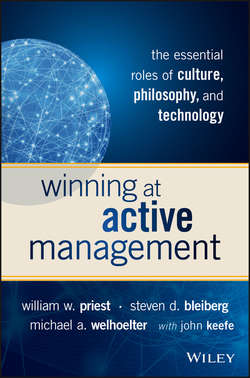Читать книгу Winning at Active Management - Welhoelter Michael A. - Страница 11
На сайте Литреса книга снята с продажи.
PART I
Culture
Chapter 2
Culture in Investment Management
ОглавлениеInvestment managers present a puzzle to understanding the prospective value of their work, even when compared to other services business. The measurement of portfolio performance has evolved considerably in the past 30 years: evaluated against a particular benchmark, the wisdom of a manager’s past decisions can be analyzed in great detail, with a galaxy of custom- designed statistics.
That said, portfolio mathematics still have trouble in definitively distinguishing luck from skill in historical results (particularly over short periods). Even the most skillful active managers sometimes underperform their benchmarks, and less skilled managers can be blessed with lucky streaks. A great active manager might outperform 60 percent of the time, but still underperform during the other 40 percent (and in truly challenging market environments, such as the one following the global financial crisis, it’s likely that many active managers will fall short).
Even more challenging is the prediction of future performance from the results of the past: some of the earliest research from financial academics went in search of predicting performance, although its success has been fleeting. One early example is the Sharpe ratio, proposed 50 years ago by Stanford professor William Sharpe, initially as a tool for forecasting the returns of mutual funds.29 More recently, the financial economists Martijn Cremers and Antti Petajisto hit on a new statistic that they hoped would have predictive value, named active share.30 Subsequent research has shown both the Sharpe ratio and active share to be informative in measuring past performance, but the industry is still in search of an effective predictor. (Investment manager skill is a topic covered in detail in Chapter 6.)31
Конец ознакомительного фрагмента. Купить книгу
29
William F. Sharpe, “Mutual Fund Performance.” The Journal of Business, Vol. 39, No. 1, Part 2: Supplement on Securities Prices (January 1966): 119–138. Accessed at http://www.edge-fund.com/Shar66.pdf.
30
Martijn Cremers and Antti Pettajisto, “How Active Is Your Fund Manager? A New Measure That Predicts Performance,” March 31, 2009. AFA 2007 Chicago Meetings Paper; EFA 2007 Ljubljana Meetings Paper; Yale ICF Working Paper No. 06-14. Available at SSRN: http://ssrn.com/abstract=891719 or http://dx.doi.org/10.2139/ssrn.891719.
31
A similar challenge of prediction plagues another service industry – Major League Baseball. In spite of a rich database of performance statistics, managers have a poor record of choosing future all-stars, even in the game’s comparatively well-controlled conditions. “The draft has never been anything but a.. crapshoot,” said Oakland A’s manager Billy Beane, in Michael Lewis’s book Moneyball (New York: W.W. Norton and Company, Inc., 2004), 17. “We take fifty guys and we celebrate if two of them make it. In what other business is two for fifty a success? If you did that in the stock market, you’d go broke.” After 2002, however, the intensive application of sabermetrics statistical analysis transformed baseball to a somewhat more disciplined business. (Sabermetrics is the empirical study of in-game baseball statistics, and takes its name from the Society for American Baseball Research.)
